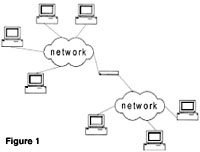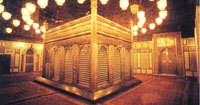
NCC teaching series:An Introduction to the Internet [Archives:2003/637/Education]
May 26 2003
 |
Academic Head
NCC Education, Yemen Center
The Internet has created a revolution in the way people and businesses work and communicate. The rate of the Internet usage is increasing rapidly in many countries of the world. The World Wide Web is the most important application of Internet technologies. As such, now no one can ignore the wide ranging impact of the Internet on our lives.
In this series I will try to elucidate the underlying technology that has caused this amazing growth. At the outset, we will explore the origins of the Internet and try to understand the context of the World Wide Web. I will also discuss the utility of some of the Internet applications. We will also try to apply some of these practical techniques that are available in the Internet. So let's begin our tour.
Internet History and Concepts
The internet system was first used in 1960s by the United States Department of Defense in a project called ARPAnet (Advanced Research Projects Agency net). The objective of the project was to design a network that could interconnect computers. This network was to be designed in such a way that a failure in any of its components would not bring the system down. The idea of “Internet” is based on the idea of “internet” (not capitalized). This idea involves computer systems which make up each of the networks, which can communicate with any other computer in the internet regardless of where the computers are located and how they are interconnected. In this system, the individual computers can communicate with each other across the internet even if the route between them passes through a network to which neither has a direct connection. In figure1 we can see two networks which are represented as clouds. These clouds are connected by communication lines like the phone lines or the satellite channels and special computer works as a gateway between the networks. This is a typical internet.
A very important point about an internet is that there is no single controlling authority or computer. This feature makes adding more networks to an internet easy and flexible.
The Internet (capitalized) is a real implementation of the internet concepts. It covers most of the world countries and provides a robust and universal computer network.
How the Internet works
We need to understand a little about how the Internet works. We will try to learn basic ideas such as how the pages move from one computer to another or how an e-mail message travels over the world to reach the receiver computer.
Packet Switched Networks
When you use the computer to send any message to the Internet, the computer converts your message into groups of bits(0s and 1s). These groups are called PACKETS. The number of the packets that are used to transfer your message depends on the size of your message. The common size of a packet is around 1500 liters plus the receiver and the sender addresses. After the computer divides the message into packets, the packets are sent independently. The packets move in the network from one computer to another and may take different routes to get to the receiver. In this case the packets share the transmitting media and components with other packets from different users. The packets might get corrupted or lost in the way to the destination. It is the responsibility of the receiver computer to check the validity of the packets and reorder them in the right sequence.
So how does your message manage to reach the destination? And which communication components are responsible for taking the decision to route the message in different routes?
Hosts
The computers that connect to the Internet are known as Hosts. Each host has a unique address, known as an IP (Internet Protocol) address. These addresses have the form a.b.c.d where a,b,c and d are numbers between 0 and 255. These addresses are added to the packets that carry the message, where the sender and the receiver IP addresses are included. For example, the IP address for Yemen Times web site is “63. 249. 207. 71”. You can get the IP address of any host in the Internet by pinging that host. For example to get the IP address of yahoo host, you go to the command line which is available in your computer and type the following command:
C:\\ ping www.yahoo.com
The reply will include the IP address for yahoo which is 64.58.76.230
Your computer will be assigned a temporary IP address given to you by the Internet service provider like yemennet so that you can connect to another host anywhere in the world using that address. The Internet consists of interconnected networks of hosts. The networks are interconnected by machines that are capable of determining the best route for a packet to take so that it moves towards its destination. The machines that carry out this role of interconnecting networks and routing packets are called routers as in Fig2.
These networks' components need to follow some Internet protocols to get the work done. Some of these protocols are
– TCP/IP
– FTP
– UDP
– DNS
Next week we will talk about these protocols.
——
[archive-e:637-v:13-y:2003-d:2003-05-26-p:education]


